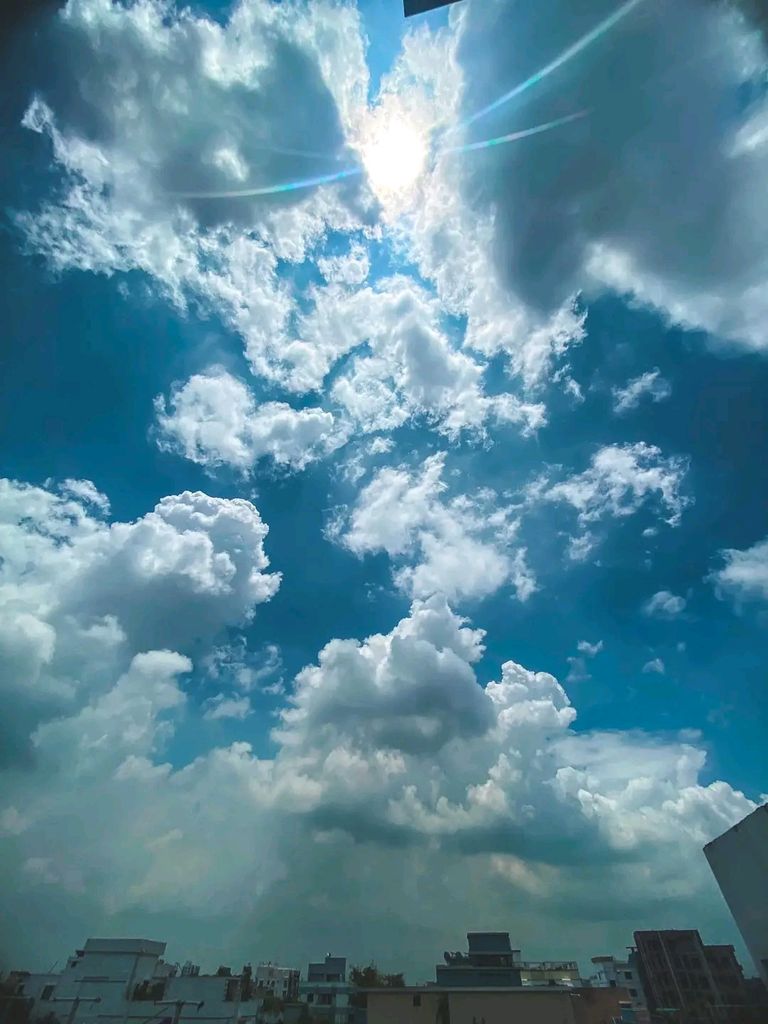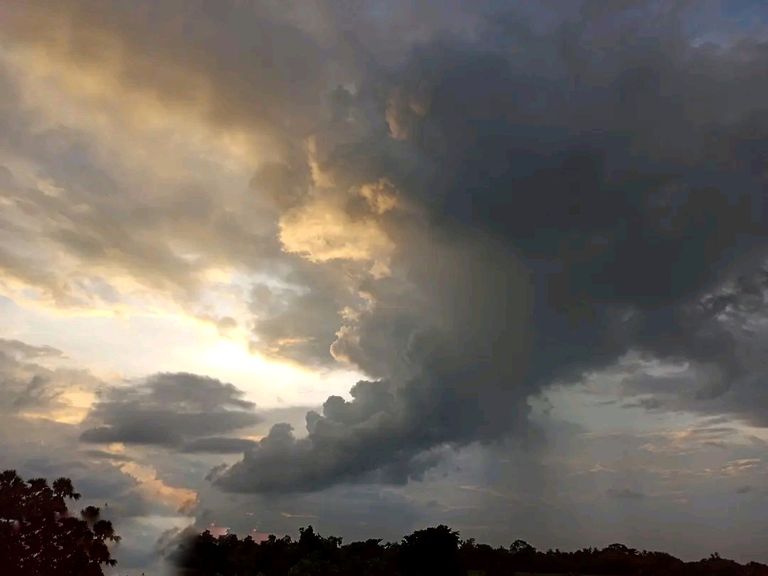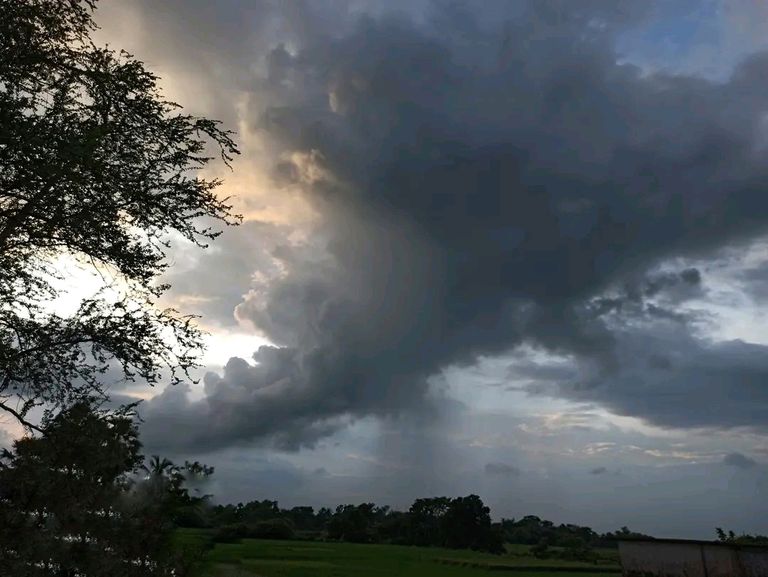Hello #BLURT Family. How are you all?
Pallikabi Jasimuddin Nakshi has described all kinds of clouds in Kantha field. No matter how many names the people of rural Bengal call him. Kalia Megh, Prabhati Megh, Kajal Megh, Dhulat Megh, Tulat Megh, Ariya Megh, Haria Megh, Sindur Megh, Kana Megh, Kalo Megh, Kuria Megh, Fultola Megh - how much more! Baribahan, Jaladhar, Kadambini, Jimut, Ghan, Baribah, Nirad, Sanvartak, Jalad, Barid, Payod, Avro, Parjanya, Payomuk - how many more nicknames! Some of them are fluent in Bengali language since ancient times, some of them are given to educated people. Not only by calling, the people of the village knew Megh, they could understand the language of Megh. The elders therefore get a hint of the weather by seeing the clouds. Our daily conversation is about the details of various clouds that are our daily companions in the sky.

The lowest level of the atmosphere is the troposphere. Among them, those at an altitude of about 6,000 feet are called stratus. The origin of the word strata is ‘Strata’ which means level. They have no special shape, but are spread all over the sky like a gray sheet.
Clouds of cotton wool can be seen floating in the autumn sky. The lower part of them is flat, and the upper part seems to be a pile of small clouds. This is why they are called stupa clouds or cumulus. Cumulus means heap. Many times many piles of cloud pieces come together to form huge cloud mountains. Then their name is Cumulonimbus. Although cumulus clouds do not usually rain, cumulonimbus can cause heavy rainfall, storms and even tornadoes.

It is better to say one thing here. In all clouds but not rain. The clouds that rain are called Nimbas. The Latin word Nimbus means ‘rain cloud’. But Nimbas or ‘rain cloud’ is not a type of cloud, it is a state of cloud.
The layer that rains in clouds or stratus is called Nimbostratus. The same is true of cumulonimbus. Cumulus clouds turn into cumulonimbus for rain. The height of cumulonimbus can be up to 10-12 km. This cloud creates intense thunderstorms.
One type of special cloud is Stratocumulus. Although these types of gray clouds are in piles, the structure of the piles is somewhat wider. They are lined up and blue sky can be seen between them. These types of clouds are less likely to rain, but they can transform into nimbostratas.

The clouds that live in the highest part of the sky are called Alok clouds or cirrus. These white clouds cover the whole sky like thin feathers. It seems that an artist has painted a white scratch on the blue canvas. Many times these clouds are arranged in a geometric manner. They are so high that their rain evaporates before they fall to the ground! Their normal habitat is above 18,000 feet above the ground. Many times this cloud goes with the signal of cyclone or cyclone.
Only light clouds may be cosmic. In addition to Earth, light clouds can be seen on Mars, Jupiter, Sun, Uranus and Neptune. No other type of cloud has been reported so far.
Cirrostratus and Cirrocumulus are two special forms of the Cirrus cloud. Since the name is ‘Cirrocumulus’, these clouds are arranged in small piles in the distant sky. They are usually seen during the winter.
Sirostratus Stratus Clouds cover a wide area like clouds, with the sun shining in the middle. This cloud is a forecast of rain or snow storm.
Besides, the area of medium height clouds is 8 thousand to 18 thousand feet. Clouds in Altostratus and Altocumulus. Altostratus is gray or bluish gray in color, covering a wide area. They are seen before storms, torrential rains or snowfall.
The color of the altocumulus is white. They are stacked like cumulus clouds, the main difference being in height. On a warm and damp morning, these clouds indicate a thunderstorm in the afternoon.
This is the primary classification of clouds. Scientists have also identified some more special clouds. Let's take a look at the top ten types of clouds.
The science of clouds began in the early nineteenth century, in 1802. The English chemist Luke Howard suggested the names of the clouds. Since the twentieth century, there has been a need for extensive research on clouds to create opportunities for people to travel by air.
Not just research or prediction, a group of cloud-crazy people have turned cloud viewing into a hobby. The name of that strange hobby is 'Cloudspotting'. They have also formed an organization, Cloud Appreciation Society or Cloud Practice Society. The UK-based organization has been around for twelve years, and has been joined by more than 40,000 cloud lovers around the world. Any cloud lover from all over the world can become a member of the organization. For this he has to pay a total of 34.19 US dollars and if he becomes a member he will get a certificate, badge and cloud selector.
Let's end today's episode by talking about a madman of this clouded group. In 2006, for the first time in the city of Cedar Rapids in the state of Iowa in the United States, a special cloud came to the notice of the cloud-mad. The shape is very strange and as far as we know about the cloud, it could not be defined in any way. It looks a lot like the waves in a huge reservoir. Some people say that the huge rough sea is hanging upside down in the sky. They also named this cloud of angry posture Yutsai, ‘Undulatus Asperatus’ or ‘Ragi Megh’.
.The Cloud Appreciation Society, or CAS, has been demanding recognition of Asperatus from the World Meteorological Organization for its place on the international cloud atlas or cloud map. But Reading University says differently. They said in a research paper that this cloud is a bit like a 'mamatus' cloud.
But Gavin Peter-Penny, the founder and president of Cass, denied that the cloud was hotter than Mamatas. Wet air currents at the top of the clouds and the air at the bottom is much drier, quite cold. One wave after another is formed during the rapid movement of air through the clouds.
Angry clouds did not have a place on the cloud map in such an argument. That's why for almost a decade, from 2006 to 2017, Cass members have been collecting pictures all over the world for the recognition of Unduletus Asperatus. Finally, on March 24 this year, on World Environment Day, Asperatus was recognized by the World Meteorological Organization. As a result, after about 7 years, the place of a new cloud is on the cloud map. The last name on the cloud map was 'Siras Intertus' in 1951.
